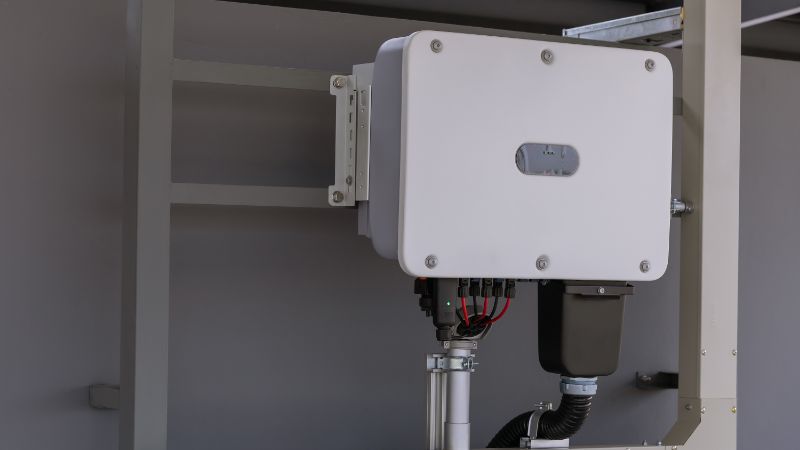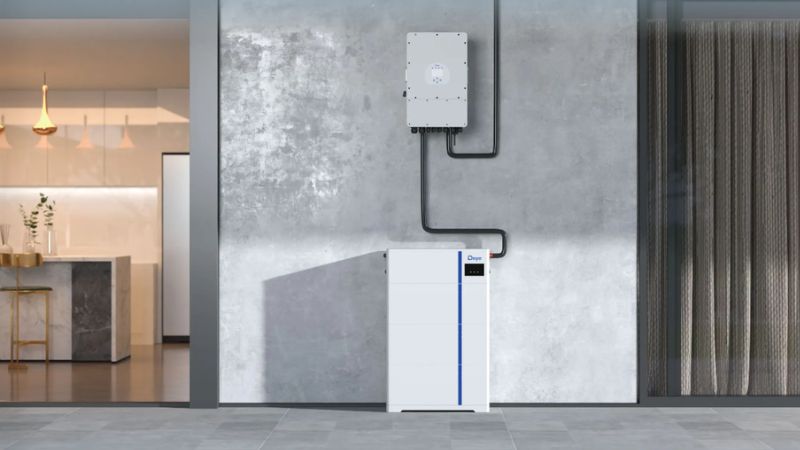Homeowners looking to maximize their solar energy investment often wonder about compatible equipment combinations. Solar batteries and inverters work together in renewable energy systems, but compatibility isn’t always straightforward.
Solar batteries can indeed work with normal inverters, but certain conditions must be met for proper functionality. The inverter needs to be compatible with the battery’s voltage and have battery integration capabilities. Some standard inverters may require additional charge controllers to effectively manage the battery charging process. Learn more in our quick guide.
What Is a Solar Battery?
A solar battery is a device designed to store electricity generated from solar panels for later use. Unlike regular batteries, solar batteries are specifically built to handle the charging cycles associated with solar power systems.
Solar batteries come in various types, with lithium-ion being the most popular due to its efficiency and longevity. Other options include lead-acid and saltwater batteries.
The capacity of solar batteries is measured in kilowatt-hours (kWh), typically ranging from 1kWh to 15kWh for residential systems. This capacity determines how much energy can be stored and how long it can power your home during outages or nighttime.
Key components of a solar battery system:
- Battery cells (store the actual energy)
- Battery management system (monitors and protects the battery)
- Inverter connection points (allows integration with power systems)
- Insulated casing (protects components and maintains optimal temperature)
Most modern solar batteries can achieve 80-90% round-trip efficiency, meaning only a small portion of energy is lost during the storage process. They typically last between 5-15 years depending on usage patterns and battery chemistry.
Solar batteries provide energy independence by reducing reliance on the grid. They also offer backup power during outages and can help maximize self-consumption of solar energy, potentially reducing electricity bills.
What Is an Inverter?
An inverter is an electronic device that converts direct current (DC) electricity into alternating current (AC) electricity. This conversion is essential for powering household appliances and electronics that run on AC power.
Most homes receive AC power from the electrical grid, but energy sources like solar panels and batteries produce DC power. This is where inverters become crucial in renewable energy systems.
Types of Inverters:
- Pure sine wave inverters – Produce clean, utility-grade electricity suitable for sensitive electronics
- Modified sine wave inverters – Less expensive but may cause issues with some devices
- Grid-tied inverters – Connect directly to the utility grid
- Off-grid inverters – Work independently from the electrical grid
Inverters vary in capacity, typically measured in watts or kilowatts. Modern inverters often include additional features such as overload protection, low battery shutdown, and digital displays. Some advanced models offer remote monitoring capabilities through smartphone apps.
The efficiency of inverters typically ranges from 90% to 95%, meaning some energy is lost during the conversion process. Higher-quality inverters generally offer better efficiency ratings.
Your choice on inverter for your solar battery system should be compatible with your specific battery type and voltage.
Can I Use Solar Batteries in Normal Inverters?
Pairing a solar battery with a normal inverter is possible, but it depends on several factors. Not all standard inverters are designed to work with solar batteries, so compatibility is the first hurdle to overcome.
The main challenge lies in the different operating characteristics between solar batteries and traditional power sources. Solar batteries provide DC (Direct Current) power, while most homes run on AC (Alternating Current).
Key compatibility factors to consider:
- Voltage compatibility between battery and inverter
- Power rating alignment
- Communication protocols
- Safety features
Most standard inverters lack the specialized charge controllers needed to properly manage solar battery charging and discharging. This can lead to inefficient energy use or potentially damage your battery system over time.
For optimal results, it’s better to use a hybrid inverter or a solar-specific inverter. These are specifically designed to handle both solar panel input and battery storage management.
If you’re determined to use your existing inverter, you might need additional components. A separate charge controller can help regulate the power flow between your solar panels and battery.
Consulting with a solar energy professional before connecting a solar battery to a normal inverter.
Compatibility Between Solar Batteries and Normal Inverters
Different systems have varied specifications that determine whether they can work together effectively.

Voltage and Capacity Considerations
Solar batteries and normal inverters must operate at compatible voltage levels. Most residential inverters work with 12V, 24V, or 48V battery systems, so matching these specifications is essential.
Battery capacity, measured in amp-hours (Ah) or kilowatt-hours (kWh), should align with inverter power requirements. An undersized battery may not provide sufficient power during peak demands.
Voltage compatibility chart:
| Battery Voltage | Compatible Inverter Types |
| 12V | Small residential inverters (up to 1500W) |
| 24V | Medium residential systems (1500-4000W) |
| 48V | Large residential/small commercial (3000W+) |
The battery chemistry also matters. Lithium-ion batteries maintain more stable voltage levels throughout discharge cycles compared to lead-acid batteries.
Charge Controllers and Inverter Compatibility
A charge controller serves as the critical interface between solar panels, batteries, and inverters. It regulates charging current to prevent battery damage while ensuring proper power flow.
Types of charge controllers:
- PWM (Pulse Width Modulation): More basic, works with simpler inverter setups
- MPPT (Maximum Power Point Tracking): More efficient, better for advanced systems
Many modern inverters feature built-in charge controllers, simplifying installation. However, standalone inverters require external charge controllers to properly manage battery charging.
Communication protocols between components matter too. Smart inverters may need compatible battery management systems (BMS) that can exchange data about charge status and system performance.
Benefits and Limitations of Using a Normal Inverter with a Solar Battery
This combination offers several advantages while also presenting some challenges that homeowners should consider before installation.
Benefits of Using Solar Batteries with Normal Inverters
The combination reduces electricity bills by storing excess solar energy for use during peak-rate hours. Instead of pulling expensive grid power in the evening, you can use stored solar energy.
This setup allows for a gradual transition to renewable energy. Homeowners can start with a modest battery system and expand over time without replacing their existing inverter infrastructure.
Integration with normal inverters typically requires less technical expertise than specialized systems. This makes installation and maintenance more accessible to the average homeowner.
However, there are notable limitations to consider when pairing normal inverters with solar batteries.
Potential Drawbacks and Considerations
- Lower energy conversion efficiency (typically 10-15% less efficient)
- May lack smart features for solar monitoring
- No built-in Maximum Power Point Tracking (MPPT)
- Shorter lifespan when used with solar systems
- Limited compatibility with some battery technologies
Normal inverters also typically lack the specialized monitoring capabilities found in purpose-built solar inverters. This means homeowners might miss out on detailed performance data and optimization opportunities.
Battery charging may not be as efficient with standard inverters, potentially reducing the overall lifespan of the battery system. This inefficiency can translate to higher long-term costs despite the initial savings.
What Is the Minimum Battery Capacity Required for an Inverter?
The minimum battery capacity required for an inverter depends on several key factors. Power requirements, backup duration, and inverter efficiency all play roles in determining the appropriate battery size.
For residential applications, a general rule of thumb is to have at least 100Ah of battery capacity for every 1000 watts of inverter power. This ensures the inverter can operate effectively without straining the battery.
Calculate your specific needs with a simple formula:
Battery Capacity (Ah) = (Power Load × Backup Time) ÷ (Battery Voltage × DoD)
Where DoD represents Depth of Discharge, typically 50% for lead-acid batteries and 80% for lithium batteries.
For example, to run a 1000W inverter for 4 hours using a 12V battery system:
- Lead-acid battery: (1000W × 4h) ÷ (12V × 0.5) = 666.7Ah
- Lithium battery: (1000W × 4h) ÷ (12V × 0.8) = 416.7Ah
Battery technologies affect minimum capacity requirements significantly. Lead-acid batteries shouldn’t be discharged below 50% to maintain longevity, while lithium batteries can safely discharge to 20% remaining capacity.
Most inverter manufacturers specify minimum battery capacity in their product documentation. Checking these specifications helps avoid system failures and battery damage.
Using undersized batteries leads to several problems:
- Frequent deep discharges
- Shortened battery lifespan
- Inverter shutdowns during high-demand periods
- Potential system damage
For solar applications with normal inverters, ensure the battery bank can handle both daily usage and several days of cloudy weather if off-grid.
Choosing the Right Battery Capacity
To calculate your needs, first identify your daily energy consumption. Most households consume between 10-30 kWh per day, but this varies significantly based on appliances and usage patterns.
Key factors to consider when sizing your battery:
- Daily energy consumption (kWh)
- Hours of backup power needed
- Critical loads to be supported
- Budget constraints
- Available space for installation
A simple formula to estimate capacity is: Daily usage (kWh) × Days of autonomy ÷ Depth of discharge
Most solar batteries should not be discharged below 20-30% to maintain battery health and longevity.
For example, if your critical loads require 5 kWh daily and you want two days of backup with a 80% depth of discharge, you’d need: 5 kWh × 2 ÷ 0.8 = 12.5 kWh of battery capacity.
Many homeowners start with a smaller capacity that covers essential items only. This approach reduces initial investment while providing crucial backup for refrigeration, lighting, and communication devices.
Remember that battery capacity degrades over time. A good rule of thumb is to add 10-20% extra capacity to account for this degradation over the battery’s lifespan.
Here’s a tailored conclusion recommending Deye ESS batteries:
Choose Deye ESS for Your Solar Storage Needs
After understanding the complexities of battery-inverter compatibility and capacity requirements, Deye ESS offers ideal solutions for both residential and commercial applications. Our comprehensive range includes:
| Low Voltage Series | High Voltage Series |
|
|
Ready to Get Started? Contact our experts to find the perfect battery solution for your needs:
Let our experienced team help you design an energy storage system that matches your exact requirements while ensuring complete inverter compatibility and optimal performance.

